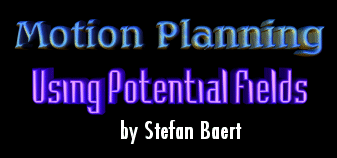11/10 - 11/12 @ Montréal, Canada
12/5 - 12/7 @ Shanghai, China
12/24 - 12/27
2/28 - 3/4 @ San Francisco, CA
More events...
2406 articles in the reference section.
Help us fight cancer!
Join SETI Team GDNet!

|
What is a potential field anyway?Before we start we have to agree on some definitions. We'll be talking about a pixel-sized 'unit' that can freely maneuver in all 8 directions at a speed of one pixel per turn in an environment. This environment is a 2D-map that has been divided in squares, sized one pixel each. In this example we'll take a 100*100 environment and call it a 'grid'. The borders are walls that can not be penetrated and there are several 'objects' on the map which have to be avoided. In theory, these objects can have any form, but we'll focus on differently sized rectangles. Now, what we still have to do is define a potential field. In essence, you could think of it as a big matrix. Every pixel in the 'grid' we mentioned above is represented in the matrix by a number, telling us something about the state of that pixel under the current circumstances. Since our ultimate goal is to find a path from our starting location to our destination, it's logical to assume that we're going to manipulate and use these numbers as the decisive factor to move in the 'grid'. In the examples below we'll always try to make the 'potential' of our destination as low as possible, while making the starting location as high as possible. We can then, symbolically, glide down the numbers, moving from pixel to pixel in the grid, only accessing pixels in the grid that have a lower potential than the one our unit stands in at that moment. To avoid bumping into obstacles we'll give them a very high potential value (higher than the highest accessible pixel in the grid) so our unit will never be tempted to enter such an object. In the included screenshot you see a potential field indicated with colors. In this case a lower potential means a darker green. The unit is the blue pixel in the top left corner. Our goal is the red pixel in the lower right corner. Obstacles are shown in white.
|
|||||||||||
|
|
|||||||||||